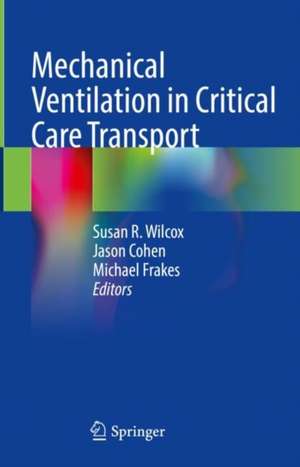Mechanical Ventilation in Critical Care Transport
Editat de Susan R. Wilcox, Jason Cohen, Michael Frakesen Limba Engleză Hardback – 18 oct 2024
The objectives of this text are to:
- Familiarize transport clinicians with common terms in mechanical ventilation,
- Review key principles of pulmonary physiology relevant to both mechanical ventilation and specific to transport,
- Understand the interpretation of blood gases as related to the management of the ventilated patient,
- Discuss the basic principles of selecting ventilator settings,
- Develop strategies for caring for ventilated patients with ARDS, asthma, COPD, trauma, and neurologic injury,
- Provide information specific to caring for ventilated neonates and pediatric patients,
- Assess and respond to emergencies during mechanical ventilation.
All transport clinicians, including experienced nurses, paramedics, emergency medicine residents, physician assistants, nurse practitioners, and EMS fellows will find this book to be of great use. Additionally, clinicians who provide emergency care for ventilated patients outside the critical care transport setting, including paramedics, emergency nurses, emergency physicians, and hospitalists will find this text valuable.
Preț: 1034.63 lei
Preț vechi: 1089.08 lei
-5% Nou
Puncte Express: 1552
Preț estimativ în valută:
198.02€ • 213.75$ • 166.04£
198.02€ • 213.75$ • 166.04£
Carte disponibilă
Livrare economică 29 martie-12 aprilie
Preluare comenzi: 021 569.72.76
Specificații
ISBN-13: 9783031667817
ISBN-10: 3031667816
Pagini: 200
Ilustrații: Approx. 200 p. 117 illus. in color.
Dimensiuni: 155 x 235 mm
Greutate: 0.5 kg
Ediția:2024
Editura: Springer Nature Switzerland
Colecția Springer
Locul publicării:Cham, Switzerland
ISBN-10: 3031667816
Pagini: 200
Ilustrații: Approx. 200 p. 117 illus. in color.
Dimensiuni: 155 x 235 mm
Greutate: 0.5 kg
Ediția:2024
Editura: Springer Nature Switzerland
Colecția Springer
Locul publicării:Cham, Switzerland
Cuprins
Introduction.- Terminology and Definitions.- Review of Respiratory Physiology and Pathophysiology.- Review of Transport Physiology.- Blood Gas Interpretation.- Modes of Ventilation.- Pressures on the Ventilator.- Types of Ventilators.- Understanding the Ventilator Screen.- Setting the Ventilator.- Acute Respiratory Distress Syndrome and Hypoxemic Respiratory Failure.- Asthma.- COPD.- Trauma.- Neuro Critical Care.- Pediatric Ventilation Management.- Neonatal Ventilation Management.- Troubleshooting the Mechanically Ventilated Patient.- Case Studies in Mechanical Ventilation in Transport.- Conclusions and Key Concepts.
Notă biografică
Susan R. Wilcox MD, FCCM
Department of Emergency Medicine
Massachusetts General Hospital
Harvard Medical School
Boston, MA
USA
Jason Cohen DO, FACEP, FCCM, FAEMS
Boston MedFlight
Bedford, MA
USA
Michael Frakes APRN, NEA-BC, FCCM, FAEN, FACHE
Brigham and Women’s Hospital
Boston MedFlight
Massachusetts
USA
Department of Emergency Medicine
Massachusetts General Hospital
Harvard Medical School
Boston, MA
USA
Jason Cohen DO, FACEP, FCCM, FAEMS
Boston MedFlight
Bedford, MA
USA
Michael Frakes APRN, NEA-BC, FCCM, FAEN, FACHE
Brigham and Women’s Hospital
Boston MedFlight
Massachusetts
USA
Textul de pe ultima copertă
This book focuses on managing mechanical ventilation and its impact on physiology, primarily in the transport environment. Mechanical ventilation is one of the most common procedures in all critical care, including critical care transport. Yet the management of ventilation poses significant risks to the patient. In the transport environment, understanding the nuances of mechanical ventilation and its impact on physiology is extremely important. Respiratory therapists and critical care physicians are essential critical care team members, but they may not be available in austere or remote locations, and consultation may not always be practical. More than ever, transport clinicians are responsible for managing ventilators according to evidence-based principles.
The objectives of this text are to:
All transport clinicians, including experienced nurses, paramedics, emergency medicine residents, physician assistants, nurse practitioners, and EMS fellows will find this book to be of great use. Additionally, clinicians who provide emergency care for ventilated patients outside the critical care transport setting, including paramedics, emergency nurses, emergency physicians, and hospitalists will find this text valuable.
The objectives of this text are to:
- Familiarize transport clinicians with common terms in mechanical ventilation,
- Review key principles of pulmonary physiology relevant to both mechanical ventilation and specific to transport,
- Understand the interpretation of blood gases as related to the management of the ventilated patient,
- Discuss the basic principles of selecting ventilator settings,
- Develop strategies for caring for ventilated patients with ARDS, asthma, COPD, trauma, and neurologic injury,
- Provide information specific to caring for ventilated neonates and pediatric patients,
- Assess and respond to emergencies during mechanical ventilation.
All transport clinicians, including experienced nurses, paramedics, emergency medicine residents, physician assistants, nurse practitioners, and EMS fellows will find this book to be of great use. Additionally, clinicians who provide emergency care for ventilated patients outside the critical care transport setting, including paramedics, emergency nurses, emergency physicians, and hospitalists will find this text valuable.
Caracteristici
Includes pedagogical features such as illustrations, tables, and diagrams Focuses on managing mechanical ventilation and its impact on physiology in the transport environment Emphasizes issues specific to transport, like physiologic changes with movement and limitations of transport equipment
